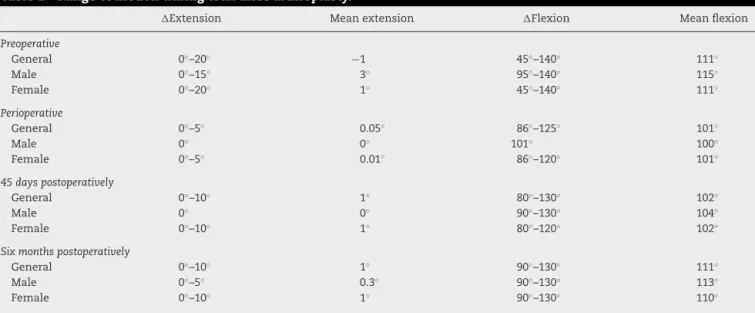SOCIEDADE BRASILEIRA DE ORTOPEDIA E TRAUMATOLOGIA
w w w . r b o . o r g . b r
Original
article
Range
of
motion
predictability
after
total
knee
arthroplasty
with
medial
pivot
prosthesis
夽
Lúcio
Honório
de
Carvalho
Júnior
a,b,c,∗,
Bruno
Presses
Teixeira
a,
Cláudio
Otávio
da
Silva
Bernardes
a,
Luiz
Fernando
Machado
Soares
a,
Matheus
Braga
Jacques
Gonc¸alves
a,
Eduardo
Frois
Temponi
aaHospitalMadreTeresa,BeloHorizonte,MG,Brazil
bUniversidadeFederaldeMinasGerais,FaculdadedeMedicina,DepartamentodoAparelhoLocomotor,BeloHorizonte,MG,Brazil
cPontifíciaUniversidadeCatólicadeMinasGerais,DepartamentodeMedicina,BeloHorizonte,MG,Brazil
a
r
t
i
c
l
e
i
n
f
o
Articlehistory: Received15April2016 Accepted13June2016 Availableonline9March2017
Keywords:
Articularmovementrange Kneearthroplasty Prosthesisdesign
a
b
s
t
r
a
c
t
Objective:To assesswhether therethe finalrange ofmotion(ROM) resultsachievedby patientsundergoingtotalkneearthroplasty(TKA)withprosthesisusingMedialPivotdesign arepredictable.
Methods:BetweenJanuaryandAugustof2014,155patientswithprimaryosteoarthritisof kneewhounderwentTKAusingtheprosthesisADVANCE®MedialPivotwereprospectively assessed. AllROMmeasuresweremadeandrecordedbefore,during,andaftersurgery. Allpatientswereclinicallyassessedpreoperativelyandpostoperatively(15,45days,three months,sixmonths,oneyear,andannuallythereafteraftersurgery);theirfunctionalstatus wasassessedusingtheWOMACquestionnaire.
Results:Significantdifferences(p<0.001)wereobservedbetweenthemeansandmediansof ROMinthepreoperativewhencomparedwiththoseduringtheperioperative;the perioper-ativevalues,whencomparedwiththoseaftersixmonthspostoperative,werealsodifferent (p<0.001).NosignificantdifferenceswerefoundbetweenthemeansandmediansROM betweentheintraoperativeperiodandatthe45-dayassessment(ns)andbetweenthemeans andmediansROMbetweenthepreoperativeperiodandatthesix-monthevaluation(ns). Conclusion: ThefinalROMachievedbypatientsthatunderwentTKAwithmedialpivot pros-thesiscanbepredicted.TheperioperativeROMcorrelateswiththatat45daysaftersurgery. ThefinalROMiscorrelatedwiththatofthepre-operativeperiod.
©2016SociedadeBrasileiradeOrtopediaeTraumatologia.PublishedbyElsevierEditora Ltda.ThisisanopenaccessarticleundertheCCBY-NC-NDlicense(http:// creativecommons.org/licenses/by-nc-nd/4.0/).
夽
StudyconductedatHospitalMadreTeresa,BeloHorizonte,MG,Brazil.
∗ Correspondingauthor.
E-mails:dufrois@hotmail.com,luciohcj@gmail.com(L.H.CarvalhoJúnior). http://dx.doi.org/10.1016/j.rboe.2017.03.001
Previsibilidade
da
amplitude
de
movimento
após
artroplastia
total
do
joelho
com
prótese
medial
pivot
Palavras-chave:
Amplitudedemovimento articular
Artroplastiadojoelho Desenhodeprótese
r
e
s
u
m
o
Objetivo:Avaliarseháprevisibilidadedaamplitudedemovimentosalcanc¸adaporpacientes submetidosaartroplastiatotaldojoelhocomprótesequeusadesenhomedialpivot. Métodos: Entrejaneiro eagostode2014foifeitaavaliac¸ãoprospectivade155pacientes comosteoartroseprimáriadojoelhosubmetidosaartroplastiatotaldojoelhocomouso dapróteseAdvance® MedialPivot.Todasasmedidasdaamplitudedemovimentosforam feitasantes,duranteeapósacirurgia.Todosospacientesforamavaliadosclinicamente nopré-epós-operatório(15,45dias,trêsmeses,seismeses,umanoedepoisanualmente apósacirurgia)paraaanálisedeseuestadofuncional.OquestionárioWesternOntarioand McMasterUniversitiesOsteoarthritisIndex(Womac)foiusado.
Resultados: Diferenc¸assignificativas(p<0,001)foramrelatadasentreasmédiasemedianas daamplitudedemovimentosnopré-operatórioemcomparac¸ãocomasmedidasobtidas noperíodointraoperatório.Asmedidasdopré-operatóriotambémsemostraramdiferentes quandocomparadascomaquelasapósseismesesdepós-operatório(p<0,001).Nãoforam encontradasdiferenc¸assignificativasentreasmédiasemedianasdaamplitudede movi-mentonacomparac¸ãodointraoperatórioeasmedidasfeitasaos45dias(ns)eentreas médiasemedianasdasmedidaspré-operatóriaseaquelasobservadasaosseismeses(ns). Conclusão:Háprevisibilidadedaamplitudedemovimentosobtidaporpacientessubmetidos aartroplastiatotaldojoelhocomprótesemedialpivot.Aamplitudeaos45diasé semel-hanteàquelaobservadanasmedidasintraoperatórias.Aamplitudefinalestárelacionadaà amplitudepré-operatória.
©2016SociedadeBrasileiradeOrtopediaeTraumatologia.PublicadoporElsevier EditoraLtda.Este ´eumartigoOpenAccesssobumalicenc¸aCCBY-NC-ND(http:// creativecommons.org/licenses/by-nc-nd/4.0/).
Introduction
Osteoarthrosisofthekneeisacommoncauseofpain, disabil-ity,anddecreasingqualityoflife,affecting41.1%ofcertain populationgroups,especiallywomenover70years.1–3Total
kneearthroplasty(TKA)isawell-establishedprocedure asso-ciated with good clinical outcomes, particularly regarding functionalimprovement.4–6
AlthoughdifferentresultsmayberelatedtoTKA,rangeof motion(ROM)recoveryisessentialforfunctionaloutcome.7,8
Severalfactorsmay influencethe post-TKAROM,including pre- and perioperative ROM, surgical technique, posterior cruciateligament(PCL)resection,prosthesisdesign,and post-operativerehabilitation.8–11 In somegroups and incertain
situations,evenROMlosshasbeendescribedafterTKA.9,11–14
Somestudiesalsodiscusstheimportanceoftheperioperative ROMasanindicatorofthefinalmovement;tothebestofthe authors’knowledge,therearenostudiesusingmedialpivot prostheses.12,13,15
Medial pivot prostheses were introduced in 1998 as a revolutionary concept in relation to the other prosthe-sesthenavailable.16 By sacrificingbothcruciate ligaments,
stability was based on the conformation of the condyle and medialplateau, making this region a spherically sta-ble center of rotation, and allowing greater movement in thelateral compartment.6,17,18Thisasymmetryattemptsto
ensurethereproductionofthecombinedmovementof rota-tion/translationnormallyobservedinhumanknees.16,18–20
Itisassumed thatahigher perioperativeROMcan pos-itively influence the ROM observed after TKA using the ADVANCE®Medial-Pivotprosthesis,whichcouldresultin bet-terfunctionalresults.Thisstudyaimedtoassesswhetheritis possibletopredictfinalROMachievedbypatientssubmitted toTKAwithamedial-pivotdesignprosthesis.
Material
and
methods
Allpatientsunderwentspinalanesthesiaassociatedwith femoral and sciatic nerve blocks, with the use of pneu-matictourniquet,anteriorlongitudinalcutaneousaccess,and medialparapatellararthrotomy.Inallcases,thefemoraland tibialcomponentswerecementedinonestage.Thepatellar componentwasnotused;however,peripatellarneurectomy wasperformedinallpatients.Theposteriorcruciateligament (PCL)wasresectedinallprocedures.
Thepatients were evaluated in the orthopedicclinic in thepostoperativeperiod.Thepreventionofthromboembolic eventswasperformedwithmechanicalandpharmacological prophylaxis.Prophylacticanticoagulationdrugswere admin-isteredtothethirdpostoperativedayatthehospital,andfor 12daysathome,totaling15days.Patientswereencouragedto walksoonafterrecoveryfromperipheralnerveblocks.Weight bearingwasallowedastoleratedwithacaneorwalkeronthe firstpostoperativeday,underthesupervisionofa physiother-apist.PassiveROMexerciseswereperformeddailyfromthe firstpostoperativedayonwards.Patientsunderwentatleast twohoursofdailyphysicaltherapy, consistingofisometric exercises,passiveROM,activeassistedROM,quadricepsand hamstringstrengthening,andgaittraining,whichincluded stairclimbing.Themeanhospitalstaywas54h.Allpatients werereferredtorehabilitationcentersforcontinuingthe reha-bilitationprogram.
Clinicalassessmentswereconductedat15,45,90,180,and 365daysaftersurgery,andannuallythereafter.AllROM mea-surementswererecordedbefore,during,andaftersurgery.All patientswereclinicallyevaluatedpreoperativelyand atthe 12-monthpostoperativeevaluationusingtheWesternOntario andMcMasterUniversitiesOsteoarthritisIndex(WOMAC).21
All ROM measurementswere obtainedin the supine posi-tion(Fig.1).Flexionmeasurementswereperformedwiththe hipat90◦ offlexion,passively,undermaximalgravitational
flexion and using a standard goniometer (Prestige Medical Goniometer,2013,Northridge,UnitedStates)asdescribedby
Leeetal.12,22 ThepreoperativeROMwasmeasured
immedi-atelybeforesurgery.Theperioperativemeasurementswere obtainedundermaximumpassivegravitationalflexionwith the hip at 90◦ offlexion, after the arthrotomy was closed
andthepneumatictourniquetwasdeflated(Video1.0).ROM was measured atthe 45-day and six-month postoperative assessments. To minimize variation among observers, all measurements were made by a single, previously trained observer.
Thestudy wasapprovedbythe EthicsCommitteeunder CAAE n◦ 38474114.2.0000.5127. All participants signed the
informedconsentpriortoenrollment.Nofinancialincentive toparticipatewasofferedtotheparticipants.
Statisticalanalysis
All datawere presented asmedians, means,and standard deviations.StatisticalanalysiswasperformedwithSPSS20® (IBMCorp.Releasedin2011.IBMSPSSStatisticsforWindows, version20.0,Armonk,NY:IBMCorp.).Thesignificancelevel wasset at0.05.Overtime, the datawastested fornormal distributionusingtheD’Agostino-Pearsontest,andwhen nec-essary,thedifferencebetweenthemeanswascalculatedusing
Fig.1–Assessmentofkneerangeofmotionduringthe processoftotalkneearthroplasty.(A)preoperative,(B) perioperative,(C)postoperative.
Student’st-testorWilcoxon’stestforthosedatainwhichthe normalityassumptionwasnotapplicable.
Results
TheROMthroughouttheanalyzedperiodisshowninTable1. Significantdifferences(p<0.001)werereportedbetweenthe mean and median preoperative ROM compared to those observed in the perioperative period. Disparity was found betweenROMmeasurementsinthepostoperativeperiod com-paredwiththosesixmonthspostoperatively.Therewereno significant differencesbetweenthe meanandmedian peri-operativeROMandthoseobtained45dayslater(ns).However, therewasameanlossof10◦whencomparedwiththe
Table1–Rangeofmotionduringtotalkneearthroplasty.
Extension Meanextension Flexion Meanflexion
Preoperative
General 0◦–20◦
−1 45◦–140◦ 111◦
Male 0◦–15◦ 3◦ 95◦–140◦ 115◦
Female 0◦–20◦ 1◦ 45◦–140◦ 111◦
Perioperative
General 0◦–5◦ 0.05◦ 86◦–125◦ 101◦
Male 0◦ 0◦ 101◦ 100◦
Female 0◦–5◦ 0.01◦ 86◦–120◦ 101◦
45dayspostoperatively
General 0◦–10◦ 1◦ 80◦–130◦ 102◦
Male 0◦ 0◦ 90◦–130◦ 104◦
Female 0◦–10◦ 1◦ 80◦–120◦ 102◦
Sixmonthspostoperatively
General 0◦–10◦ 1◦ 90◦–130◦ 111◦
Male 0◦–5◦ 0.3◦ 90◦–130◦ 113◦
Female 0◦–10◦ 1◦ 90◦–130◦ 110◦
aftersixmonths.Therewasnostatisticaldifferencebetween genders,although ashorterROM wasobserved duringthe perioperativeperiodinmen,whichdidnotimplyashorter ROMinthepostoperativeperiod.
TheWOMACindexrangedfrom21.87to80.24,withamean of49.63inthepreoperativeperiod.Inthepostoperative anal-ysis(12months),themeanWOMACscorewas73.71,ranging between53.12and88.54(p<0.0001).
Discussion
Themostimportantfinding ofthis studywas the relation-shipbetweentheperioperativeROMmeasurementsandthose obtainedat45dayspostoperatively.Thisfindingmay repre-sentthemarkerforthosepatientswhowould benefitfrom greaterattentionandcareduringtherehabilitationprocess.It canalsobeusedasagoaltobeachievedpostoperativelyorasa markerofnormalityinpatientsevolution.Norelationshipwas observedbetweentheperioperativemeasuresandtheROM achievedsixmonthsaftersurgery.Forthisperiod,the preop-erativemeasurementswereshowntobereliableandallowed thepredictionofthefinalROM.Itisimportanttonotethat thepostoperativeROMandthatat45daysaftersurgerywere significantlyshorterthan inthe preoperativeperiod,which reinforcestheimportanceofsurgicalaggression,pain,andthe healingprocessinROMrecovery.8,23,24
Several authors analyzed ROM after arthroplasty with the use of the medial-pivot design and found a relation-ship between preoperative ROM and that obtained after surgery.4,5,23,25–27 Shakespeare et al.28 compared 261 knees
undergoing arthroplasty with medial-pivot prosthesis with 913casesinwhich TKA withPCLsacrifice wasperformed. TheyfoundnodifferencebetweentheirROMsobtainedafter 12monthsoffollow-up.Karachaliosetal.25analyzed284TKA
withmedial-pivotdesignandfoundimprovedROM(101◦
pre-operativelyand117◦inthefinalevaluation).Andersonetal.23
described298primaryTKAinfivecenters.Flexionimproved from107◦preoperativelyto121◦ atthelastfollow-upexam.
Inthepresentstudy,maintenanceofpreoperativeROMwas
observed,althoughwithlowervaluesthanthoseobservedin otherstudies.Whenstratifyingbygender,asimilarROM pro-gression wasobserved, withhigherabsolutevaluesamong men,demonstratingnofinalrepercussiononthemeasured values.
Few studieshaveexamined the importanceof perioper-ative ROM.12,13,15 Leeetal.12observedthatthe finalflexion
measurement observed in patients with poor preoperative flexion (<85◦) could be provided by intraoperative
mea-surement (gravitational measurement), rather than by the preoperativevalue. Ritteretal.15 observedthat the
periop-erativeandpostoperativeflexionwererelated,andthatthe perioperative ROM was the best predictor ofpostoperative ROM. Kotani et al.10 found a positive correlation between
preoperativeROMandthoseobservedatthreemonthsand oneyearpostoperative,butnoclearcorrelationwasobserved two years aftersurgery. In the present study,the relation-ship between perioperative ROM and that observed at 45 postoperativedayswerenotrelatedtothemeasurements per-formedatsixmonths.ThefactthattheperioperativeROMwas measuredpassively,usinggravityandwithoutactivemuscle contraction,mayexplainthedifferencebetweenitsvaluesand the measurementsatsixmonthspostoperatively,inwhich rehabilitationandrecoveryofmusclestrengthcouldhave con-tributedtotheimprovementinROM.10,13,29
RecoveryafterTKAisassociatedwithdecreasedpainand consequent functional improvement. These achievements canbemeasuredwhenanalyzingtheWOMACquestionnaire. Pritchettetal.20assessedtheclinicalimpressionofpatients
afterTKA;76%ofthepatientspreferredpivotalmedial pros-thesescomparedtothose inwhichthe PCLwassacrificed, and 61% preferred those with medial-pivot design when comparedwithprostheses withmobileplatform.Anderson etal.23examined204kneeswith5.4yearsoffollow-upand
reported asignificantimprovementinfunctional outcomes comparedtothe preoperativeperiod.Baeetal.24compared
arthroplastieswith6.7yearsoffollow-up.Significant improve-mentswereobservedintheWOMAC(30.8preoperative;79.2 final),SF-12 (26.6preoperative; 47 final),and Oxford scores (44.4preoperative;22.6final).Inthepresentstudy,functional outcomeimprovementwasobservedafter12months,despite themaintenanceofthesamepreoperativeROM.
Thepresentstudyhadsomelimitations.Theevaluationof differentprosthesisdesignscoulddetermineiftheROMwould followthepatternobservedinthepresentstudy.Further stud-iesareneededtoassessthereproducibilityofROMmeasures and whether thereisfunctional and ROMimprovement in thecomparisonofprostheseswithmedial-pivotdesignwith theotherdesigns.Anotherlimitationofthepresentstudyis thefactthatROMwasmeasuredwithastandard goniome-ter,ratherthanwithradiographicmeasurements,whichmay haveresultedinlessreliablevalues.Thefactthatallthe eval-uationswereperformedwiththesameinstrumentandbythe sameresearcher,previouslyvalidatedinapilotstudy,reduces thesignificanceofthislimitation.22
Thisstudyisimportantforinformingorthopedicsurgeons tobe alertto the ROMduring TKA recovery. Patients with ROMlossaftersurgery(within45days)shouldbecounseled regardingtheirprogression.ThosewhorecoverROM,butat alowerthanexpectedrate,shouldbeconsideredforgreater attentionandcareintherehabilitationprocess,evenserving asanalertforpossiblemanipulationunderanesthesia.
Conclusion
Itispossibleto predictthe final range ofmotionobtained by patients submitted to total knee arthroplasty with medial-pivotprosthesis.Thepreoperativerangeofmotionis correlatedwiththefinalpostoperativerangeofmotion.The perioperativerangeofmotioniscorrelatedwiththatobserved 45daysaftersurgery.
Conflicts
of
interest
OnlyL.H.C. Jr has made paid presentations and actsas a
paidconsultantatMicroportOrthopedics.Theotherauthors declarenoconflictsofinterest.
Acknowledgements
Toallresearchersandresearchparticipants.
r
e
f
e
r
e
n
c
e
s
1. ReginatoAM,RieraH,VeraM,TorresAR,EspinosaR,Esquivel JA,etal.OsteoarthritisinLatinAmerica:studyof
demographicandclinicalcharacteristicsin3040patients.J ClinRheumatol.2015;21(8):391–7.
2. PlotnikoffR,KarunamuniN,LytvyakE,PenfoldC,
SchopflocherD,ImayamaI,etal.Osteoarthritisprevalence andmodifiablefactors:apopulationstudy.BMCPublic Health.2015;15:1195.
3. LeeS,KimSJ.Prevalenceofkneeosteoarthritis,riskfactors, andqualityoflife:theFifthKoreanNationalHealthand
NutritionExaminationSurvey.IntJRheumDis.
2015;(November),http://dx.doi.org/10.1111/1756-185X.12795 [Epubaheadofprint].
4.BaeDK,ChoSD,ImSK,SongSJ.Comparisonofmidterm clinicalandradiographicresultsbetweentotalknee arthroplastiesusingmedialpivotandposterior-stabilized prosthesis–amatchedpairanalysis.JArthroplasty. 2016;31(2):419–24.
5.FitchDA,SedackiK,YangY.Mid-tolong-termoutcomesofa medial-pivotsystemforprimarytotalkneereplacement:a systematicreviewandmeta-analysis.BoneJointRes. 2014;3(10):297–304.
6.VecchiniE,ChristodoulidisA,MagnanB,RicciM,RegisD, BartolozziP.Clinicalandradiologicoutcomesoftotalknee arthroplastyusingtheAdvanceMedialPivotprosthesis.A mean7yearsfollow-up.Knee.2012;19(6):851–5.
7.IshiiY,NoguchiH,MatsudaY,TakedaM,KigaH,ToyabeS. Rangeofmotionduringtheperioperativeperiodintotalknee arthroplasty.ArchOrthopTraumaSurg.2008;128(8):795–9. 8.DennisDA,KomistekRD,StiehlJB,WalkerSA,DennisKN. Rangeofmotionaftertotalkneearthroplasty:theeffectof implantdesignandweight-bearingconditions.JArthroplasty. 1998;13(7):748–52.
9.FarahiniH,MoghtadaeiM,BagheriA,AkbarianE.Factors influencingrangeofmotionaftertotalkneearthroplasty.Iran RedCrescentMedJ.2012;14(7):417–21.
10.KotaniA,YonekuraA,BourneRB.Factorsinfluencingrangeof motionaftercontemporarytotalkneearthroplasty.J
Arthroplasty.2005;20(7):850–6.
11.SugitaniK,AraiY,TakamiyaH,TerauchiR,NakagawaS, UeshimaK,etal.Factorsaffectingrangeofmotionaftertotal kneearthroplastyinpatientswithmorethan120degreesof preoperativeflexionangle.IntOrthop.2015;39(8):
1535–40.
12.LeeDC,KimDH,ScottRD,SuthersK.Intraoperativeflexion againstgravityasanindicationofultimaterangeofmotion inindividualcasesaftertotalkneearthroplasty.J
Arthroplasty.1998;13(5):500–3.
13.RitterMA,HartyLD,DavisKE,MedingJB,BerendME. Predictingrangeofmotionaftertotalkneearthroplasty. Clustering,log-linearregression,andregressiontreeanalysis. JBoneJointSurgAm.2003;85(7):1278–85.
14.CarvalhoJúniorLH,CastroCAC,Gonc¸alvesMBJ,Rodrigues LCM,CunhaFVP,LopesFL.Amplitudedemovimentoapós artroplastiatotaldojoelho.ActaOrtopBras.2005;13(5):233–4. 15.RitterMA,CampbellED.Effectofrangeofmotiononthe
successofatotalkneearthroplasty.JArthroplasty. 1987;2(2):95–7.
16.BlahaJD.Amedialpivotgeometry.Orthopedics. 2002;25(9):963–4.
17.MiyazakiY,NakamuraT,KogameK,SaitoM,YamamotoK, SuguroT.Analysisofthekinematicsoftotalkneeprostheses withamedialpivotdesign.JArthroplasty.2011;26(7): 1038–44.
18.BarnesCL,BlahaJD,DeBoerD,StemniskiP,ObertR,CarrollM. Assessmentofamedialpivottotalkneearthroplastydesign inacadaverickneeextensiontestmodel.JArthroplasty. 2012;27(8),1460.e1–1468.e1.
19.KomistekRD,DennisDA,MahfouzM.Invivofluoroscopic analysisofthenormalhumanknee.ClinOrthopRelatRes. 2003;(410):69–81.
20.PritchettJW.Patientspreferabicruciate-retainingorthe medialpivottotalkneeprosthesis.JArthroplasty. 2011;26(2):224–8.
22.GogiaPP,BraatzJH,RoseSJ,NortonBJ.Reliabilityandvalidity ofgoniometricmeasurementsattheknee.PhysTher. 1987;67(2):192–5.
23.AndersonMJ,KruseRL,LeslieC,LevyLJJr,PritchettJW,Hodge J.Medium-termresultsoftotalkneearthroplastyusinga mediallypivotingimplant:amulticenterstudy.JSurgOrthop Adv.2010;19(4):191–5.
24.BaeDK,SongSJ,ChoSD.Clinicaloutcomeoftotalknee arthroplastywithmedialpivotprosthesisacomparative studybetweenthecruciateretainingandsacrificing.J Arthroplasty.2011;26(5):693–8.
25.KarachaliosT,RoidisN,GiotikasD,BargiotasK,VaritimidisS, MalizosKN.Amid-termclinicaloutcomestudyofthe AdvanceMedialPivotkneearthroplasty.Knee. 2009;16(6):484–8.
26.MoonotP,MuS,RailtonGT,FieldRE,BanksSA.Tibiofemoral kinematicanalysisofkneeflexionforamedialpivotknee. KneeSurgSportsTraumatolArthrosc.2009;17(8):927–34. 27.ChinzeiN,IshidaK,TsumuraN,MatsumotoT,KitagawaA,
IguchiT,etal.Satisfactoryresultsat8yearsmeanfollow-up afterAdvance®medial-pivottotalkneearthroplasty.Knee. 2014;21(2):387–90.
28.ShakespeareD,LedgerM,KinzelV.Flexionaftertotalknee replacement.AcomparisonbetweentheMedialPivotknee andaposteriorstabilisedimplant.Knee.2006;13(5):371–3. 29.NishioY,OnoderaT,KasaharaY,TakahashiD,IwasakiN,

